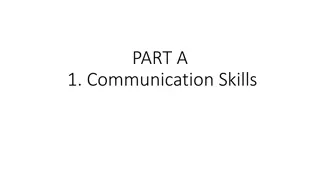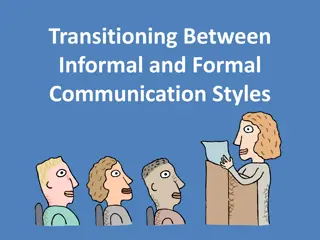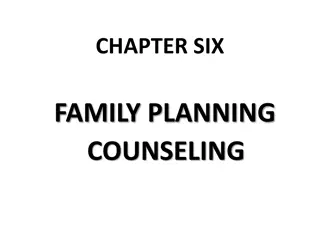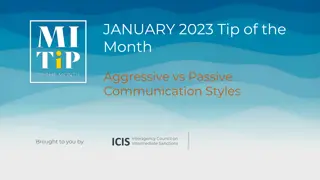Impact of Communication Styles on Counseling and Social Work in Multicultural Settings
Exploring the influence of communication styles on counseling and social work in diverse cultural contexts, this study delves into the nuances of verbal and nonverbal communication, including proxemics, kinesics, and paralanguage. It highlights the importance of adapting interventions to align with cultural beliefs and practices to ensure effective multicultural counseling. The role of communication in recognizing and addressing mental health disorders within cultural frameworks is also examined.
Download Presentation

Please find below an Image/Link to download the presentation.
The content on the website is provided AS IS for your information and personal use only. It may not be sold, licensed, or shared on other websites without obtaining consent from the author.If you encounter any issues during the download, it is possible that the publisher has removed the file from their server.
You are allowed to download the files provided on this website for personal or commercial use, subject to the condition that they are used lawfully. All files are the property of their respective owners.
The content on the website is provided AS IS for your information and personal use only. It may not be sold, licensed, or shared on other websites without obtaining consent from the author.
E N D
Presentation Transcript
COMMUNICATION STYLES AND ITS IMPACT ON COUNSELING AND SOCIAL WORK Dr. Reshawna Chapple, PhD, LCSW University Of Central Florida School of Social Work 1
INTRODUCTION Compare and contrast styles of communication between various racial/ ethnic/ Recognize nonverbal communications and their cultural meanings. Counseling styles and roles may create barriers to effective multicultural counseling. Nonverbal communication can (a) trigger off racial biases and fears, and (b) reflect our true beliefs and feelings. 2
INTRODUCTION Proxemics, kinesics, paralanguage, and high-/ low-context communications are likely to affect communication. Theories of counseling and psychotherapy can be distinguished by their communication or helping styles. Explain the implications communication styles have for therapeutic intervention techniques. 3
Cultural Expression of Mental Disorders A client s background, culture and age can influence how psychological distress is expressed. Culture can also influence how psychological distress is perceived. Assessments and interventions should be adapted to cultural beliefs and practices.
Communication Styles It is important that the social worker and client send and receive both verbal and nonverbal messages accurately and appropriately. Counselors can sometimes be more concerned with the accuracy of communication than with whether the communication is appropriate.
Nonverbal Communication What people say can be either enhanced or negated by their nonverbal communication. Ex. Mental Disorders (Bipolar Mania or Depression) Ex. Attitude can influence the message being delivered Generally occurs outside the level of conscious awareness Varies from culture to culture Over or under diagnosis can occur by culture
Proxemics Proxemics refers to perception and use of personal and interpersonal space (e.g. norms of physical distance). Violation may cause one to withdraw, become angry, or create conflict. Some cultures are okay with being very close. In Western culture, people seem to grow more uncomfortable when others stand too close rather than too far away. If the social worker/counselor backs away, this may be seen as coldness. Social work/counselor may misinterpret client s closeness.
Kinesics Kinesics refers to bodily movements (e.g., facial expression, posture, gestures, eye contact): Japanese smile may mean discomfort. Latin Americans shake hands with vigor. Eye contact varies according to culture. Asian and Latino/Hispanic Cultures vs. Black or African American Cultures
Paralanguage Paralanguage refers to vocal cues other than words (i.e., loudness of voice, pauses, silences, etc.): Social workers may misinterpret silences or speaking in a soft tone. Speaking loudly may not indicate anger but rather a cultural style.
High-Low Communication A high-context (HC) communication or message is one that is anchored in the physical context (situation) or internalized in the person. Low-context (LC) cultures place a greater reliance on the verbal part of the message.
Context in Communication Directness of a conversation or the degree of frankness also varies considerably among cultures. High-Context Communication anchored in the physical context is less reliant on explicit code (e.g., many Asian cultures) Low-Context Communication places greater reliance on verbal parts of the message (e.g., Western)
Sociopolitical Facets of Nonverbal Communication Nonverbal as reflections of bias Nonverbal as triggers to bias and fears In general, people of color prefer more active, directive forms of helping than nondirective ones.
NONVERBALS AS REFLECTIONS OF BIAS Nonverbal communication least under conscious control Operate primarily at unaware level More spontaneous, more difficult to censor or falsify May reveal conscious deceptions or unconscious bias Minorities may use nonverbal cues as a means of psychological survival Minority groups hold contrasting communication styles May confuse counselors with different backgrounds 13
COUNSELING AS A COMMUNICATION STYLE Counseling posses varied communication styles Counseling s race/culture can influence helping style Communication styles differ depending on the group Due to cultural and sociopolitical factors 14
DIFFERENTIAL SKILLS IN MULTICULTURAL Counseling Black counselors typically use more active expressive skills Utilize directions, expression of content, interpretation May include practical advice Allows for interjection of counselor s values/opinions White males and females frequently use attending skills BIPOC Clients tend to prefer counselors of same race and ethnicity Most apparent with Asian American clients 15
IMPLICATIONS FOR CLINICAL PRACTICE Counseling style and client communication styles should match Ideally, therapeutic style should mold to needs of client Minority clients may prefer influencing approach White clients typically prefer passive approach 16
IMPLICATIONS FOR CLINICAL PRACTICE Social workers must engage in variety of helping styles and roles Be aware of own communication/helping styles Training programs should consider cultural and racial factors 17
Counseling approaches must adapt to sociodemographic characteristics Nonverbal communication may enhance content of a message Communication style strongly manifested through nonverbal Race and culture may influence nonverbal behavior Dimensions of nonverbal communication Proxemics- use of personal space Kinesics- bodily movements Paralanguage- vocal cues High and low context, context vs content SUMMARY 18























